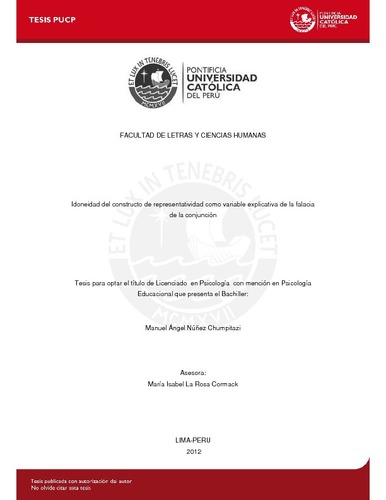| dc.contributor.advisor | La Rosa Cormack, María Isabel | es_ES |
| dc.contributor.author | Nuñez Chumpitazi, Manuel Ángel | es_ES |
| dc.date.accessioned | 2013-03-14T01:18:08Z | es_ES |
| dc.date.available | 2013-03-14T01:18:08Z | es_ES |
| dc.date.created | 2012 | es_ES |
| dc.date.issued | 2013-03-13 | es_ES |
| dc.identifier.uri | http://hdl.handle.net/20.500.12404/4426 | |
| dc.description.abstract | La presente investigación busca proveer nuevos elementos de análisis para discutir la idoneidad del constructo de representatividad como variable explicativa de la falacia de la conjunción. Sendos estudios se llevaron a cabo en dos grupos de 33 y 92 estudiantes preuniversitarios de entre 16 y 21 años. El primer estudio, de carácter exploratorio y cualitativo, analiza las respuestas a una variante de la tarea original utilizada por Kahneman y Tversky (1983). Los objetivos de este estudio eran determinar la tasa de falacias en una población local e identificar patrones de razonamiento en las respuestas de los participantes frente a una tarea similar a la propuesta por Kahneman y Tversky. El segundo estudio, de naturaleza más cuantitativa, buscaba determinar el efecto sobre la tasa de falacias de las variables “contexto” y “formato”. La primera está relacionada con la presencia o no de un enunciado previo al cuestionario; la segunda, corresponde al número de preguntas que se presentaba a continuación de cada situación. Los resultados indican que aun cuando la tasa de falacias en la muestra es similar a la hallada por Kahneman y Tversky, ninguno de los participantes hizo uso de un razonamiento formal identificándose seis patrones de razonamiento no excluyentes entre sí. Asimismo, ni la ausencia de enunciado ni el aumento en el número de preguntas provocó una disminución significativa de la tasa de falacias. Los resultados dan cuenta de la importancia de emplear un enfoque cualitativo en el estudio de este tema y de la existencia de otros factores que explican la falacia de la conjunción tales como la dificultad de la activación de esquemas extensionales o las concepciones erróneas sobre el tratamiento de las probabilidades. | es_ES |
| dc.description.abstract | This research aims to provide new elements of analysis to discuss the suitability of the construct of representativeness as an explanatory variable of the conjunction fallacy. Two separate studies were conducted in two groups of 33 and 92 pre-college students aged 16 to 21 years. The first study, exploratory and qualitative, analyzes responses to a variant of the original task used by Kahneman and Tversky (1983). The objectives of this study were to determine the rate of fallacies in a local population and identify patterns of reasoning in the answers of the participants facing a task similar to that proposed by Kahneman and Tversky. The second study, more quantitative nature, sought to determine the effect on the rate of fallacies of variables "context" and "format". The first is related to the presence or absence of a statement prior to the questionnaire; the second is the number of questions that are presented below for each situation. The results indicate that although the rate of fallacies in the sample is similar to that found by Kahneman and Tversky, none of the participants made use of formal reasoning and identified six patterns of reasoning are not mutually exclusive. Likewise, neither stated nor the absence of the increase in the number of questions caused a significant decrease in the rate distortion. The results show the importance of using a qualitative approach in the study of this topic and the existence of other factors that explain the fallacy of conjunction such as the difficulty of extensional schema activation or misconceptions about the treatment of probabilities. | es_ES |
| dc.language.iso | spa | es_ES |
| dc.publisher | Pontificia Universidad Católica del Perú | es_ES |
| dc.rights | Atribución-NoComercial-SinDerivadas 2.5 Perú | * |
| dc.rights | info:eu-repo/semantics/openAccess | es_ES |
| dc.rights.uri | http://creativecommons.org/licenses/by-nc-nd/2.5/pe/ | * |
| dc.subject | Falacias (Lógica) | es_ES |
| dc.title | Idoneidad del constructo de representatividad como variable explicativa de la falacia de la conjunción | es_ES |
| dc.type | info:eu-repo/semantics/bachelorThesis | es_ES |
| thesis.degree.name | Licenciado en Psicología Educacional | es_ES |
| thesis.degree.level | Título Profesional | es_ES |
| thesis.degree.grantor | Pontificia Universidad Católica del Perú. Facultad de Letras y Ciencias Humanas. | es_ES |
| thesis.degree.discipline | Psicología Educacional | es_ES |
| renati.discipline | 313046 | es_ES |
| renati.level | https://purl.org/pe-repo/renati/level#tituloProfesional | es_ES |
| renati.type | http://purl.org/pe-repo/renati/type#tesis | es_ES |
| dc.publisher.country | PE | es_ES |
| dc.subject.ocde | http://purl.org/pe-repo/ocde/ford#5.01.00 | es_ES |






